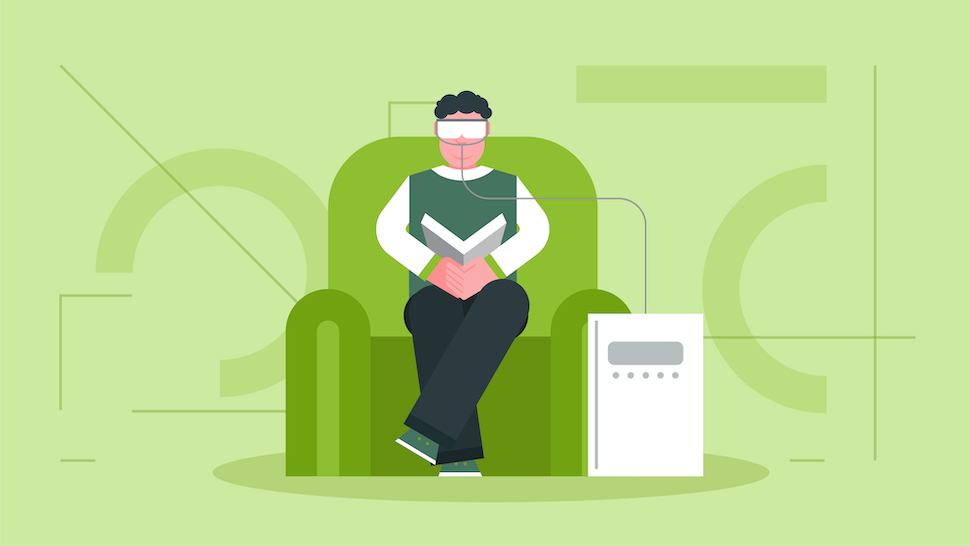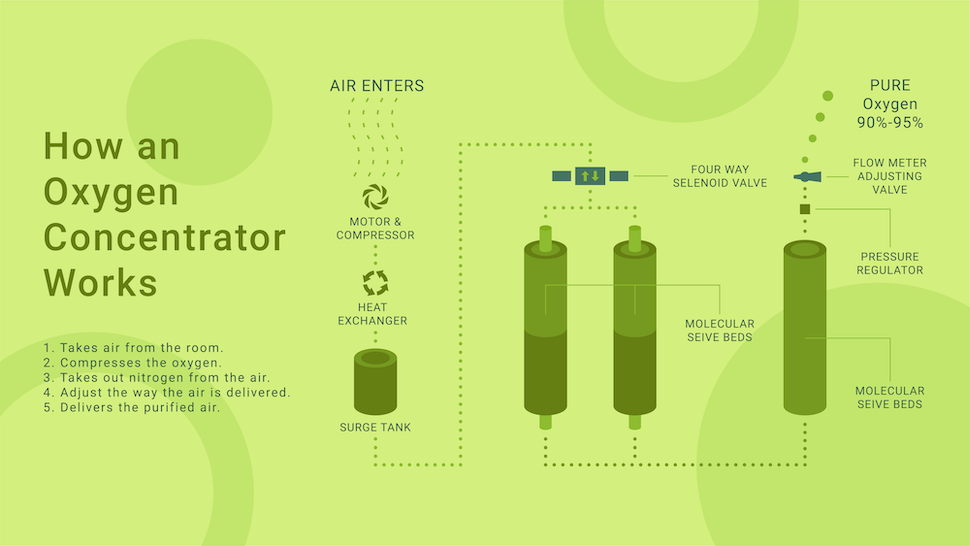A high-level look at these popular medical devices and why you might use one
Oxygen concentrators are a popular way of administering oxygen therapy or adding supplemental oxygen to PAP therapy without many of the hassles or safety concerns of using oxygen tanks.

Understanding how oxygen concentrators work and some best practices for safe use will help to ensure that you get the most from your oxygen therapy and avoid common pitfalls.
In this guide, we’ll look at why you might need an oxygen concentrator, common concentrator designs, the typical components used with oxygen concentrators to deliver oxygen therapy, and provide some best practices for safe, effective operation of these popular devices.
Why Would You Need an Oxygen Concentrator?
Oxygen therapy is a common short-term or long-term treatment for a number of respiratory conditions and illnesses which cause you to have low oxygen levels, including:
- Asthma
- Pneumonia
- Respiratory Distress Syndrome (RDS)
- Lung cancer
- Chronic Obstructive Pulminary Disease (COPD)
- Cystic fibrosis
- Sleep apnea
- Influenza (the Flu)
- COVID-19 (Coronavirus)
A prescription is required for safe, effective oxygen therapy and to purchase oxygen concentrators and other therapy devices.
If you suspect you might benefit from oxygen therapy, bring it to the attention of your primary care provider or family doctor.
They can recommend diagnostic options to determine if oxygen therapy is right for you and to help establish therapeutical oxygen levels for optimal symptom management.
Never use an oxygen concentrator or receive oxygen therapy without the approval and guidance of a medical professional. Doing so can cause more harm than good, including severe lung damage.
How Oxygen Concentrators Work
Unlike oxygen delivery systems which rely on refillable tanks, oxygen concentrators pull oxygen from the surrounding air.
The air you breathe is made up of, on average, about 80% nitrogen. By removing the nitrogen in the ambient air around you, these machines deliver a concentrated stream of oxygen (often in purity ranging from 90 to 95-percent) for you to breathe.

The ability to draw the oxygen from the surrounding air means that the concentrators can operate around the clock with minimal downtime and no need to swap tanks or schedule tank deliveries.
The typical oxygen concentrator can provide between 5 to 10 litres per minute (LPM) of oxygen depending on your needs.
Common Oxygen Concentrator Designs

Oxygen concentrators typically fit into one of two styles:
- Portable Oxygen Concentrators (POCs): Typically small enough to carry in a backpack or side bag, these concentrators can weigh as little as 1.5kg up to around 9kg.
While not entirely effortless to carry about, you can often walk through the store or generally move about while using them.
They use a battery for power and often deliver oxygen in a pulse dose instead of a steady stream — though there are some exceptions to this. - Stationary or Home Oxygen Concentrators: These are larger concentrators typically intended to be set up and used in a single location.
While you can likely load one in your car for transport or move your concentrator between rooms, the size and weight make it less than ideal for frequent moving.
Since they require connection to a power source, you won’t be able to use them on the go even if you wanted to carry them around.
Oxygen Concentrator Parts Explored
Oxygen concentrators feature a number of components or accessories similar to those used with CPAP machines.
Outside of the primary concentrator device, you’ll commonly use:
- Tubing and/or a facemask
- A humidifier bottle
- A concentrator filter
The tubing typically uses small tips (known as a nasal cannula) designed to rest beneath your nose or just inside your nostrils, delivering oxygen directly into your nasal passages as you breathe.

Masks are sometimes recommended for more concentrated oxygen delivery or when tubing cannot provide enough airflow for your needs.
In fact, many CPAP masks provide a means of connecting a concentrator or other oxygen source to the mask! For those that don’t, a bleed connector offers convenient access to oxygen supplementation while using a CPAP machine.
The humidifier bottle helps to moisturize the oxygen delivered by your concentrator. It is typically filled with distilled water and should be kept clean to avoid unsightly growth or odours and ensure safe operation of your oxygen concentrator.
Concentrator filters help to remove dirt, dust, dander, animal hair, or anything else that might be floating around in the air around you. This is to protect both you and your equipment.
As such, you ensure your filter remains clean for optimal concentrator operation and safety.
Best Practices for Oxygen Concentrator Use
With an understanding of the various parts and how they work, you’re ready to start using your oxygen concentrator. Your doctor or healthcare specialist should provide you with in-depth instructions on the best usage habits and settings for your needs.
However, the following tips are a solid baseline for anyone requiring oxygen therapy or adding supplemental oxygen to their PAP therapy routines.
- Avoid open flames
- Do not smoke while using your oxygen concentrator
- Provide plenty of room for air to circulate around your concentrator
- Keep your concentrator and tubing out of high-traffic areas to avoid trips and falls
- Do not block the vents on your concentrator
- Never attempt to modify settings on your concentrator without doctor approval
- Always report operating inconsistencies or alerts to a medical professional as soon as possible
CPAP Supply offers a comprehensive selection of home and portable oxygen concentrators and accessories for use with oxygen therapy or as supplemental oxygen for use with CPAP machines. Contact us today to learn more about our selection and experience why CPAP Supply is Canada’s leading online CPAP supply store in customer satisfaction!
REFERENCES:
- WebMD: What is an Oxygen Concentrator?
- The U.S. Food and Drug Administration (FDA): Pulse Oximeters and Oxygen Concentrators: What to Know About At-Home Oxygen Therapy
- Apollo 24/7: Oxygen Concentrators: Everything You Need to Know
- Wikipedia: Oxygen Concentrator
- The American Lung Association: Gettings Started with a Home Oxygen Concentrator
